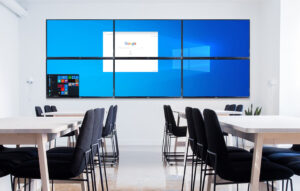Video Wall Display is a large visual display made up of multiple individual screens or monitors seamlessly tiled together to create a single, cohesive, and often expansive viewing surface. Video walls are designed to showcase high-quality content, including videos, images, data, and interactive elements, in a dramatic and impactful way. These displays are used in a variety of applications where a larger and more visually impressive screen is required. Let’s explore what a Video Wall Display is, why it is used, and where it finds applications:

What is a Video Wall Display?
A Video Wall Display consists of several key components:
Why Use a Video Wall Display?
Where Are Video Wall Displays Used?

Video Wall Displays continue to evolve with advancements in display technology, offering higher resolutions, thinner bezels, and improved content management systems. Their ability to captivate audiences, deliver information, and enhance visual experiences makes them a valuable tool in numerous professional, commercial, and public settings.
Transportation: Airports and train stations use video walls to display real-time flight or departure information, wayfinding, and advertising to enhance the traveler experience.
Hospitality: Restaurants, bars, and event venues employ video walls for sports viewing, live performances, and interactive customer engagement, creating an immersive atmosphere.
Manufacturing and Industrial: Manufacturing facilities often use video walls for process monitoring, quality control, and displaying critical production data in real-time.
Trade Shows and Exhibitions: At trade shows and conventions, businesses and exhibitors use video walls to create eye-catching booths, display product demos, and engage with event attendees.
Art Installations: Artists and designers use video walls to create innovative and interactive art installations that blend technology and creativity, allowing viewers to engage with art in new ways.
Data Centers: Data center operators rely on video walls to monitor the status of servers, network equipment, and data traffic in real-time.
Public Safety: Emergency operations centers and police departments use video walls to coordinate responses to crises and display critical information for first responders.
Financial Trading: In financial institutions, video walls are used in trading rooms to monitor stock market data, financial news, and real-time trading activities.
Research and Development: Research institutions and laboratories use video walls for data visualization, simulations, and collaborative research presentations.
Event and Entertainment Production: Event production companies use video walls to create immersive stage backdrops, visual effects, and live event experiences.
The versatility and adaptability of Video Wall Displays make them invaluable tools for organizations across a wide range of industries. As technology continues to advance, with features like 4K and 8K resolutions, seamless bezel-free designs, and advanced content management systems, video walls are likely to play an even more prominent role in delivering captivating and impactful visual experiences. Whether for informative purposes, branding, entertainment, or communication, video walls are a powerful medium for conveying messages and creating immersive environments.
Retail Analytics: Retailers utilize video walls with integrated analytics software to track customer behavior, such as dwell time and interaction with displayed products, enabling data-driven merchandising decisions.
Training and Simulation: Military and aviation training centers employ video walls for realistic simulations, pilot training, and mission planning, offering trainees immersive and high-fidelity experiences.
Stadiums and Arenas: Sports stadiums and arenas use video walls to provide instant replays, display live game statistics, and engage fans with interactive content during sporting events and concerts.
Control Rooms: Large-scale control rooms, such as those in energy utilities and transportation hubs, rely on video walls for comprehensive monitoring, emergency response coordination, and incident management.
Art Galleries: Art galleries and cultural institutions use video walls to showcase digital art exhibitions and multimedia installations that transcend traditional artistic boundaries.
Collaborative Workspaces: Modern offices and co-working spaces incorporate video walls in shared areas for collaborative brainstorming sessions, data visualization, and dynamic presentations.
Brand Promotion: Companies use video walls in flagship stores and marketing events to create immersive brand experiences, share brand stories, and engage customers on a deeper level.
Customer Engagement: Interactive video walls with touch or gesture control allow customers to explore product catalogs, customize options, and make informed decisions in retail environments.
Storytelling: Storytelling experiences, such as historical exhibits and interactive storytelling installations in museums, benefit from the dynamic capabilities of video walls to convey narratives effectively.
Science Communication: Scientific institutions and planetariums use video walls to showcase astronomy visuals, simulations, and educational content, providing audiences with immersive learning experiences.
Video Wall Displays have become a cornerstone technology in numerous industries, enriching communication, enhancing brand presence, facilitating decision-making, and captivating audiences. As display technologies continue to evolve, with advancements like curved displays, OLED technology, and enhanced interactivity, the potential applications and benefits of video walls are expected to expand even further. These versatile displays remain at the forefront of innovative visual communication and engagement.